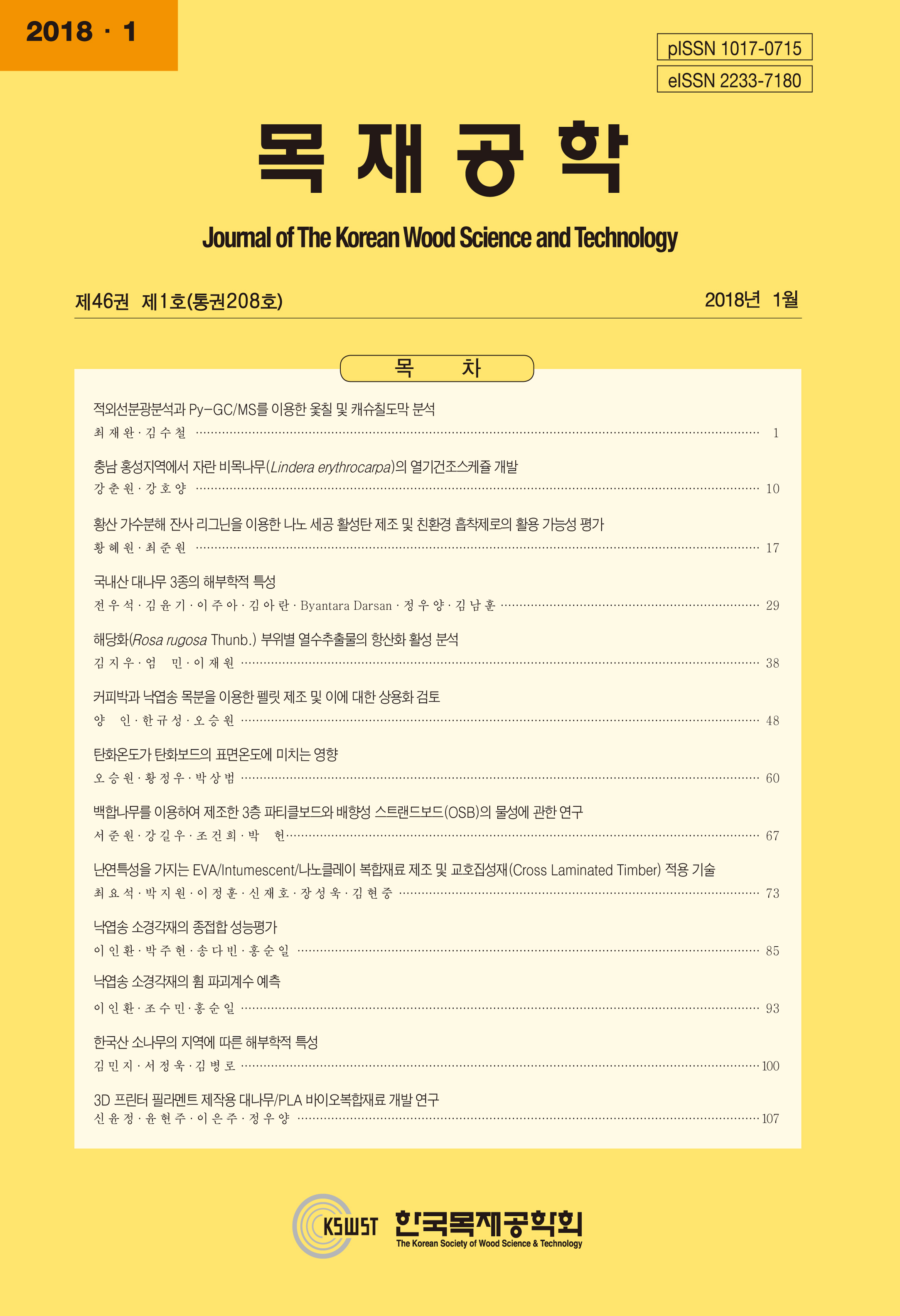본 연구에서는 당화 공정 중 축합된 구조로 발생되는 고형 부산물인 황산리그닌(Sulfuric acid lignin; SAL)의 나노세공 탄소 소재로의 활용 가능성을 살펴보고자 수산화칼륨 촉매를 투입하여 750℃에서 1 h 동안 고온 촉매 활성화 공정을 진행하였다. 이때 타 바이오매스 시료 유래 활성탄과의 물성 비교를 위해 코코넛셸(CCNS), 소나무(Pinus), Avicel로부터 각각 같은 방법으로 활성탄을 제조하였으며 화학 조성과 결합 구조, 표면 및 기공 분포 특성을 분석하였다. 열중량 분석 결과 최종 온도 750℃에서 잔존 고형분 함량은 SAL > CCNS > Pinus > Avicel 순서였으며 이 경향은 활성화 공정 후 생성된 활성탄의 수율 순서와 동일하였다. 특히, SAL 유래 활성탄은 탄소 함량이 91.0%, Id/Ig peak ratio가 4.2로 가장 높게 나타났으며 이는 높은 탄소 고정성과 더불어 비정질의 거대 방향족 구조층이 형성되었음을 의미한다. 또한 제조된 활성탄은 모두 최초 시료의 비표면적(6 ㎡/g)과 기공 부피(0.003 ㎤/g)에 비해 촉매 활성화 공정 후 각각 1065 ∼ 2341 ㎡/g, 0.412 ∼ 1.270 ㎤/g로 크게 증가하였으며 이 중 SAL 유래 활성탄의 표면 변화율이 가장 크게 나타났다. 이후 3종의 유기 오염물질(페놀, 2,4-Dichlorophenoxyacetic acid, 카보퓨란)에 대한 제거율을 평가해보았을 때 모든 활성탄에서 표준 용액 100 ppm 대비 90 mg/g 이상의 높은 흡착 능력을 보였다. 따라서 축합된 구조인 SAL으로부터 고비표면적의 나노 세공 활성탄 제조가 가능할 뿐만 아니라 추후 유기 오염 물질 제거를 위한 카본필터의 친환경 흡착 소재로 활용가능성이 높을 것으로 기대된다.
In this study, catalytic activation using sulfuric acid lignin (SAL), the condensed solid by-product from saccharification process, with potassium hydroxide at 750℃ for 1 h in order to investigate its potential to nanoporous carbon In this study, catalytic activation using sulfuric acid lignin (SAL), the condensed solid by-product from saccharification process, with potassium hydroxide at 750℃ for 1 h in order to investigate its potential to nanoporous carbon material. Comparison study was also conducted by production of activated carbon from coconut shell (CCNS), Pinus, and Avicel, and each activated carbon was characterized by chemical composition, Raman spectroscopy, SEM analysis, and BET analysis. The amount of solid residue after thermogravimetric analysis of biomass samples at the final temperature of 750℃ was SAL > CCNS > Pinus > Avicel, which was the same as the order of activated carbon yields after catalytic activation. Specifically, SAL-derived activated carbon showed the highest value of carbon content (91.0%) and Id/Ig peak ratio (4.2), indicating that amorphous large aromatic structure layer was formed with high carbon fixation. In addition, the largest changes was observed in SAL with the maximum BET specific surface area and pore volume of 2341 ㎡/g and 1.270 ㎤/g, respectively. Furthermore, the adsorption test for three kinds of organic pollutants (phenol, 2,4-Dichlorophenoxyacetic acid, and carbofuran) were conducted, and an excellent adsorption capacity more than 90 mg/g for all activated carbon was determined using 100 ppm of the standard solution. Therefore, SAL, a condensed structure, can be used not only as a nanoporous carbon material with high specific surface area but also as a biosorbent applied to a carbon filter for remediation of organic pollutants in future.




